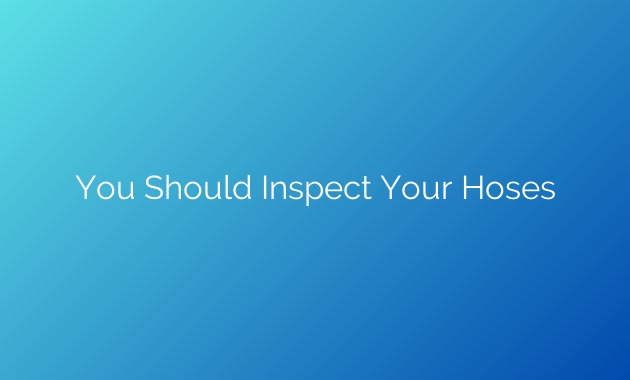Contents
- 1 You Should Inspect Your Hoses
- 1.1 Why Should You Inspect Your Hoses?
- 1.2 When Should You Inspect Your Hoses?
- 1.3 What Should You Look for During Inspection?
- 1.4 How to Inspect Your Hoses?
- 1.5 Conclusion
- 1.6 Frequently Asked Questions (FAQs)
- 1.6.1 1. How often should I inspect my hoses?
- 1.6.2 2. Can I use my equipment if I find minor hose damage during inspection?
- 1.6.3 3. Are there any specific tools required for hose inspection?
- 1.6.4 4. What should I do if I find a hose that needs to be replaced?
- 1.6.5 5. Can I extend the lifespan of my hoses with regular inspections?
You Should Inspect Your Hoses
Regular maintenance of your hoses is crucial to ensure the optimal performance and longevity of your equipment. Whether you own a Car, a garden, or any other machinery that relies on hoses, inspecting them should be a top priority. In this article, we will discuss the importance of inspecting your hoses, key points to consider, and how it can help prevent potential accidents or breakdowns.
Why Should You Inspect Your Hoses?
1. Safety First: Inspecting your hoses regularly helps ensure that they are in good working condition, reducing the risk of any accidents or injuries caused by hose failures.
2. Prevent Costly Repairs: By identifying and addressing any issues early on, you can prevent minor problems from escalating into major ones, saving you from expensive repairs or replacements.
3. Maintain Efficiency: Hoses play a crucial role in various systems, such as cooling, heating, or fluid transfer. Regular inspections help maintain the efficiency of these systems, saving energy and enhancing overall performance.
4. Prolong Lifespan: Proper maintenance, including regular inspections, can significantly extend the lifespan of your hoses. This translates to savings in the long run, as you won’t need to replace them as frequently.
When Should You Inspect Your Hoses?
It is recommended to inspect your hoses at least once every three months. However, depending on the type of equipment, environmental factors, and frequency of use, you may need to inspect them more frequently. Additionally, it is crucial to inspect hoses after any extreme weather conditions or significant changes in temperature.
What Should You Look for During Inspection?
During your hose inspection, pay attention to the following factors:
1. Cracks or Abrasions: Check for visible cracks, abrasions, or any signs of wear and tear on the surface of the hose. These can indicate potential weak points that may lead to leaks or bursts.
2. Bulges or Swelling: If you notice any bulges or swelling along the hose, it may be a sign of internal damage or weakening. Replace the hose immediately to avoid any accidents or failures.
3. Leakage: Inspect the hose connections for any signs of leakage. Even minor leaks can lead to significant problems and should be addressed promptly.

4. Hardening or Softening: Hoses should have a certain level of flexibility. If you notice any hardening or softening of the hose material, it may be an indication of deterioration and the need for replacement.
5. Proper Clamping: Check if the hose clamps are secure and properly attached. Loose or damaged clamps can cause leaks and should be replaced immediately.
How to Inspect Your Hoses?
Inspecting your hoses is a straightforward process. Follow these simple steps:
1. Ensure Safety: Turn off all equipment and allow it to cool down before inspecting the hoses to prevent any burns or injuries.
2. Visual Inspection: Examine the hoses from end to end, looking for any visible signs of damage, such as cracks, bulges, or leakage.
3. Manual Check: Gently squeeze the hoses to feel for any soft spots or swelling that may indicate internal damage.
4. Check Connections: Inspect the connections and clamps for any signs of looseness, leakage, or damage.
5. Document Findings: Keep a record of your inspection findings, including any issues discovered or maintenance tasks performed.
Conclusion
Regular inspection of your hoses is a crucial part of equipment maintenance. By inspecting your hoses for signs of wear, damage, or leaks, you can ensure the safety, efficiency, and longevity of your equipment. Investing a little time in routine inspections can save you from costly repairs, accidents, and unexpected breakdowns. Make hose inspection a regular part of your maintenance routine and enjoy the peace of mind that comes with knowing your equipment is in optimal condition.
Frequently Asked Questions (FAQs)
1. How often should I inspect my hoses?
It is recommended to inspect your hoses at least once every three months. However, depending on usage and environmental factors, more frequent inspections may be necessary.
2. Can I use my equipment if I find minor hose damage during inspection?
It is always best to replace or repair damaged hoses before using the equipment. Using equipment with damaged hoses can lead to further issues and potential accidents.
3. Are there any specific tools required for hose inspection?
No, hose inspection can be done visually and manually. However, having a flashlight can be helpful to inspect hard-to-reach areas or areas with limited lighting.
4. What should I do if I find a hose that needs to be replaced?
If you discover a hose that requires replacement, it is recommended to use the manufacturer-recommended hose or consult a professional to ensure compatibility and proper installation.
5. Can I extend the lifespan of my hoses with regular inspections?
Yes, regular inspections and proper maintenance can significantly extend the lifespan of your hoses, saving you from frequent replacements.
